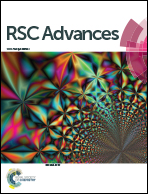Graphene oxide-based fluorescence molecularly imprinted composite for recognition and separation of 2,4,6-trichlorophenol
Abstract
In this work, multifunctional molecularly imprinted polymers (MIPs) based on CdTe quantum dots (QDs) and graphene oxide (GO) were prepared for selective recognition and separation of 2,4,6-trichlorophenol (2,4,6-TCP). GO was used to improve the adsorption capacity and sensing rate of MIPs. CdTe QDs offered a readout signal to monitor the amount of 2,4,6-TCP bound to the imprinted matrix. The molecularly imprinted shell provided analyte selectivity. The prepared composite was evaluated and characterized by scanning electron microscopy, transmission electron microscopy, fluorescence spectroscopy, fluorescence microscopy, Raman spectroscopy, thermo gravimetric analysis, and X-ray diffraction analysis. MIPs were successfully applied to direct fluorescence quantification of 2,4,6-TCP. The linear relationship was from 0.2 to 40 μmol L−1, with a detection limit of 0.18 μmol L−1 which provided a simple and selective sensing system for recognition of 2,4,6-TCP. Moreover, a molecularly imprinted solid phase extraction (MISPE) method followed by high performance liquid chromatography (HPLC) for detection of 2,4,6-TCP was also established. The linear relationship was from 0.02 to 2.5 μmol L−1 with a detection limit of 0.25 ng mL−1, which was more suitable to determine trace 2,4,6-TCP.



 Please wait while we load your content...
Please wait while we load your content...